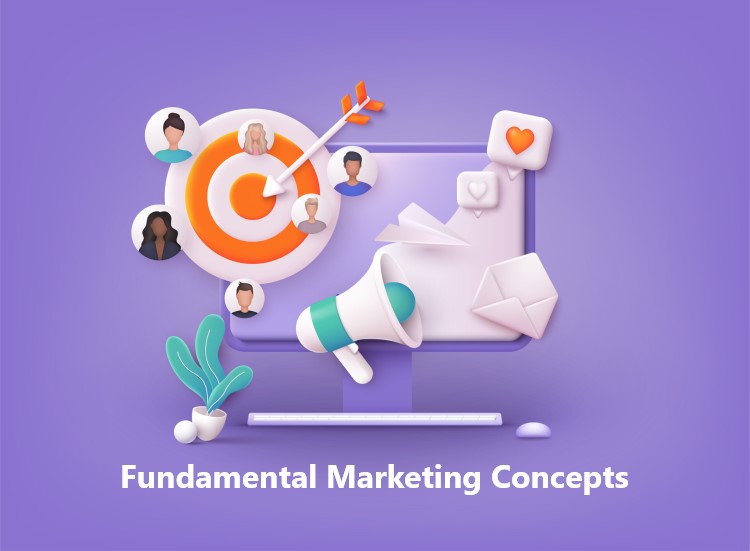
Below we’ll explore how to retain customers, build brand loyalty, and ultimately achieve strategic goals. Whether you are a seasoned marketing professional or new to the field, understanding these core concepts is crucial. Grasping them ensures the creation of campaigns that are not only creative but also strategically sound and results-driven. We’ll also get into the nuances of consumer behavior, market segmentation, and effective marketing outcomes measurement. These are all critical in today’s constantly changing market environment.
The Marketing Mix (4 Ps: Product, Price, Place, Promotion)
The Marketing Mix, consisting of Product, Price, Place, and Promotion, is one of the fundamental marketing concepts that businesses utilize. Each component plays a critical role in building a comprehensive marketing strategy. Starting with ‘Product,’ businesses must carefully design and develop offerings that not only satisfy customer needs but also stand out. This involves decisions regarding product design, features, quality, and packaging. A well-developed product that meets specific consumer demands lays the foundation for effective marketing.
‘Price’ is the next critical element, encompassing the strategy behind setting a product’s cost to the consumer. Pricing decisions should reflect the perceived value of the product, competitive prices, production costs, and market demand. Effective pricing strategies ensure profitability while remaining attractive to consumers, balancing cost with quality to meet different consumer segments’ expectations.
‘Place’ refers to how the product is distributed and made available to customers. This includes selecting appropriate distribution channels to ensure products are accessible in convenient locations at the right times. Whether it’s through physical stores or e-commerce platforms, the goal is to maximize visibility and accessibility to enhance customer satisfaction.
Lastly, ‘Promotion’ involves all activities aimed at communicating the product’s benefits to target customers. This includes advertising, sales promotions, public relations, and personal selling. Promotion strategies are vital for raising awareness, generating interest, and driving sales. By effectively communicating the value proposition, businesses can differentiate their product in the marketplace and encourage trial and loyalty.
Market Segmentation and Targeting
Market segmentation and targeting are among the fundamental marketing concepts that enable businesses to efficiently allocate their resources and tailor their marketing efforts to specific groups. This strategy involves dividing a broad consumer market into subgroups of individuals who share similar characteristics, such as demographics, psychographics, geographic locations, or behavior.
The first step, market segmentation, allows companies to identify and understand these distinct groups within the larger market. For instance, a company might segment its market based on age, income, lifestyle, or purchasing habits. This process is crucial because it helps marketers to more deeply understand potential customers’ needs, preferences, and buying behavior, which are essential for crafting compelling marketing messages.
Following segmentation, targeting involves selecting one or more of these segments to focus the company’s marketing efforts on. This decision is based on the segments’ attractiveness and the company’s ability to serve them uniquely and effectively. For example, a luxury car brand might target higher-income segments that value premium features and status.
Effective targeting means that marketing strategies are specifically designed to appeal to the selected segment’s unique needs and desires. This can involve tailoring product features, adjusting pricing models, designing customized promotions, and choosing distribution channels that best reach the chosen segment.
By employing market segmentation and targeting, businesses can achieve more efficient and effective marketing. These strategies ensure that marketing efforts are not wasted on those less likely to be interested in the product, thereby optimizing marketing spend and increasing the likelihood of converting prospects into customers. This focus is a key component of executing the fundamental marketing concepts necessary for any successful marketing strategy.
Consumer Behavior
Understanding consumer behavior is crucial and stands as one of the fundamental marketing concepts that guide businesses in tailoring their strategies to meet market demands. Consumer behavior involves studying how individual customers, groups, or organizations select, buy, use, and dispose of goods, services, ideas, or experiences to satisfy their needs and desires. This knowledge is vital as it influences every aspect of marketing strategy, from product development to communication approaches.
Consumer needs and preferences are the starting points that dictate the design and features of products. Marketers need to delve deep into these aspects to ensure that their offerings align with consumer expectations and desires. For instance, a rise in health consciousness among consumers has led many food companies to introduce organic or low-calorie options. Such adaptations are made to cater to the evolving preferences of the target audience.
The decision-making process is another critical area of consumer behavior. This process varies significantly among consumers and is influenced by cultural, social, personal, and psychological factors. Marketers must understand these influences to craft messages that resonate deeply and drive purchasing decisions. Effective marketing campaigns are often those that address or trigger these factors, thereby encouraging consumers to choose one brand over another.
Moreover, the advent of digital technology has transformed consumer behavior, with more information available and easier access to a variety of products. This shift requires marketers to adopt new strategies and tools to engage with the modern consumer, who is more informed and has higher expectations.
A thorough understanding of consumer behavior helps companies to design better products, improve marketing strategies, and achieve greater customer satisfaction. By focusing on how consumer needs, preferences, and decision-making processes shape buying behavior, businesses can more effectively influence their target audiences and enhance their market presence.
Branding and Positioning
Branding and positioning are critical elements of the fundamental marketing concepts that significantly impact a business’s ability to compete and thrive in the marketplace. Creating a unique brand identity and effectively positioning it within the market are key strategies that differentiate a company’s products or services from its competitors, forging a distinct presence that resonates with consumers.
A strong brand identity is more than just a memorable logo or catchy slogan; it encompasses the values, personality, and key attributes of the business that are consistently communicated to the audience. This identity helps to establish a relationship with customers, fostering loyalty and trust. For example, brands that consistently emphasize quality, innovation, or customer service can embed these values into their public perception, which, in turn, influences buying decisions.
Positioning, on the other hand, involves defining where your brand sits in the marketplace relative to competitors. It is about identifying the specific niche in the market that the brand will occupy and the unique value proposition it offers. Effective positioning ensures that marketing messages strike a chord with the right audience. It makes clear what the brand stands for and why it is the preferable choice over others.
Moreover, the strategic use of branding and positioning can dramatically enhance a company’s market visibility and consumer perception. These marketing efforts work together to communicate a cohesive image and message, which helps to attract and retain customers in a crowded market.
The integration of branding and positioning is essential for any business aiming to establish a strong market presence. These strategies are pivotal in building a distinctive brand that appeals to targeted consumers and stands out in the competitive landscape. Understanding and implementing these fundamental marketing concepts is crucial for achieving long-term success and relevance in the industry.
Digital Marketing and Social Media
Digital marketing and social media are integral parts of the fundamental marketing concepts that shape today’s competitive landscape. These platforms offer businesses unparalleled opportunities to reach a broad audience efficiently and cost-effectively. As consumer behaviors shift towards online spaces, the importance of digital strategies becomes even more pronounced.
Digital marketing encompasses a range of practices including search engine optimization (SEO), pay-per-click advertising (PPC), email marketing, and content marketing. Each of these techniques leverages digital technologies to target specific demographics and engage with them in meaningful ways. For instance, SEO optimizes website content to increase visibility in search engine results, driving organic traffic to the site. PPC, on the other hand, involves sponsored online advertisements that appear at the top of search engine results, providing immediate visibility and rapid traffic generation.
Social media platforms like Facebook, Instagram, Twitter, and LinkedIn transform how businesses connect with their customers. These channels allow for direct interaction and personalized engagement with audiences. Businesses can share content, respond to customer inquiries, and promote products with immediate feedback from consumers. This level of interaction enhances customer relationships and fosters loyalty.
Moreover, social media analytics provide valuable insights into consumer preferences and behavior, enabling marketers to refine their strategies and improve targeting. The ability to track engagement and analyze data helps businesses to optimize their campaigns and maximize return on investment.
Digital marketing and social media are crucial components of modern marketing strategies. They allow businesses to engage with customers where they spend a great deal of their time—online. Embracing these digital tools is essential for any business looking to thrive in the digital age, as they are foundational to effectively implementing fundamental marketing concepts in today’s digital-first world.
Measuring Marketing Effectiveness (KPIs and ROI)
Measuring the effectiveness of marketing campaigns is crucial and heavily relies on key performance indicators (KPIs) and return on investment (ROI). These are both fundamental marketing concepts. Understanding these metrics is vital for evaluating how well marketing efforts perform and their impact on business success.
KPIs are specific, quantifiable metrics used to assess the performance of various marketing activities. Common KPIs include website traffic, conversion rates, lead generation numbers, and customer engagement levels. Each KPI offers insights into different campaign aspects, aiding marketers in identifying effective strategies and areas needing improvement. For example, a low conversion rate may lead to revising the campaign’s call to action or the user experience on the landing page.
ROI, meanwhile, measures the profitability of marketing investments. It is calculated by subtracting the marketing activity cost from the revenue it generates and then dividing this by the cost. This metric is essential for gauging the financial success of marketing efforts and justifying expenditures.
Moreover, tracking these metrics allows businesses to make data-driven decisions that enhance marketing strategies and optimize budget allocation. Effective use of KPIs and ROI metrics ensures that marketing efforts align with business objectives and achieve maximum impact.
Conclusion
In conclusion, effectively applying fundamental marketing concepts is essential for any business looking to succeed in today’s competitive landscape. Mastering the marketing mix and leveraging digital platforms are crucial for shaping a strong marketing strategy. Additionally, the ability to segment the market, understand consumer behavior, and establish a strong brand identity is key to engaging the right audience.
Furthermore, the importance of measuring marketing effectiveness is paramount. Using metrics like KPIs and ROI allows businesses to assess their marketing efforts and make decisions that enhance growth and profitability. These tools help marketers fine-tune their strategies, optimize resources, and achieve better outcomes.
Ultimately, integrating these fundamental marketing concepts helps businesses develop robust, effective campaigns that resonate with consumers and drive sustainable success. As the market evolves, our marketing approaches must also adapt, always adhering to the core principles that ensure effectiveness in this dynamic field.


